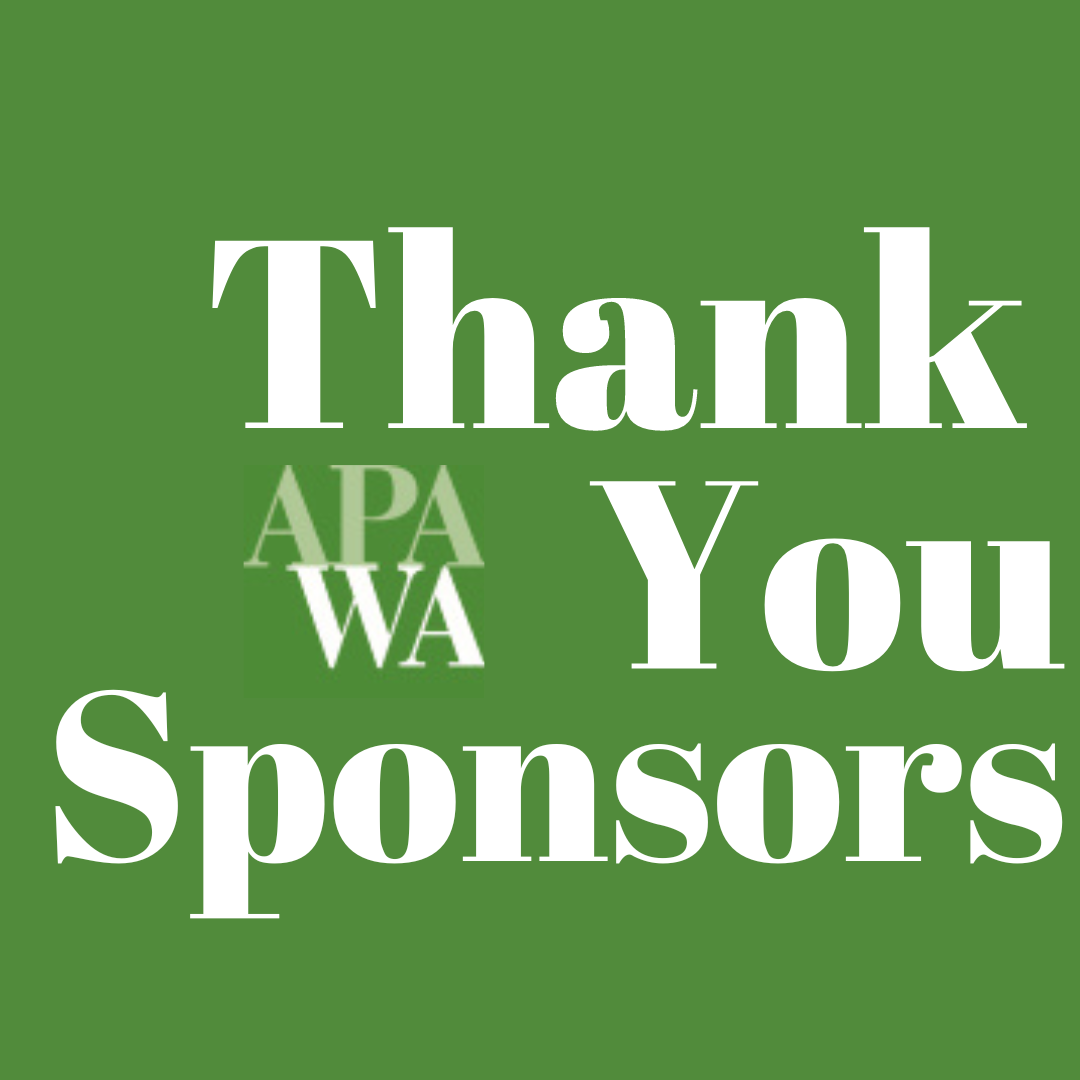3.3 Energy
Energy - its generation, supply and emissions – plays a central role in determining the livability of cities and
towns in Washington State. Fossil fuels such as gasoline and diesel for transportation and heating oil and
natural gas for buildings are significant sources of greenhouse gas (GHG) emissions in Washington as in
other states. Unlike many other states, however, Washington benefits from an abundant supply of nearly
emissions-free electrical energy from hydroelectric dams.
Along with our already stringent state energy code standards, this means that Washington has lower
emissions than many other states. Washington’s I-937 renewable energy portfolio standard (now codified
as RCW 19.285) mandates that the state’s seventeen largest utilities achieve 15% of their energy from
renewable sources by 2020.
In the future, population growth and limited hydroelectric supplies will increase the pressure on communities
around the state to reduce energy use and seek low emission energy supplies to ensure adequate energy
and maintain Washington’s livability. Because all electricity resources in the west are interconnected,
conserving energy in Washington will help reduce GHG emissions throughout a larger area.
Energy Greenhouse Gas Emissions
Although transportation is the single largest contributor source of GHG emissions in Washington, the
generation of electricity combined with industrial, residential and commercial oil or natural gas heating
account for 37% of the state’s GHG emissions (Figure 1). Fossil-fueled electricity production from in-state
and out-of-state generators is a growing source of greenhouse gas pollution, as the region has outgrown
its hydroelectric capacity. Conflicts between power generation and fish management requirements will
continue to limit available hydroelectric generation.[1]
Figure 1: Sources of Greenhouse Gas Emissions in Washington State (2004)[2]
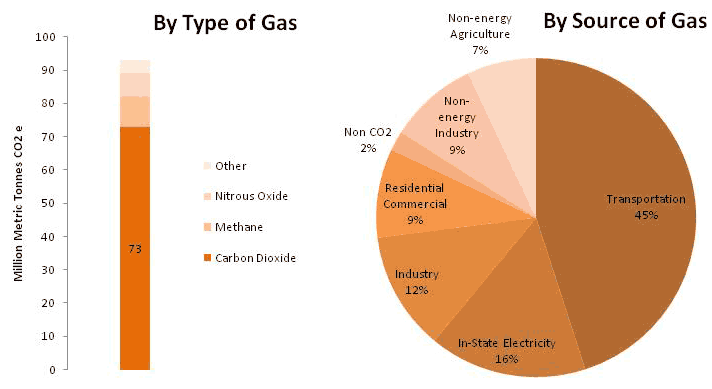
Figure 2 shows how transportation emissions have grown to dominate statewide GHG
emissions – a result of inexpensive, subsidized fossil fuels, federal highway planning priorities, and
local land use patterns.
Figure 2: Historical Trends of CO2 Use Emissions by Sector
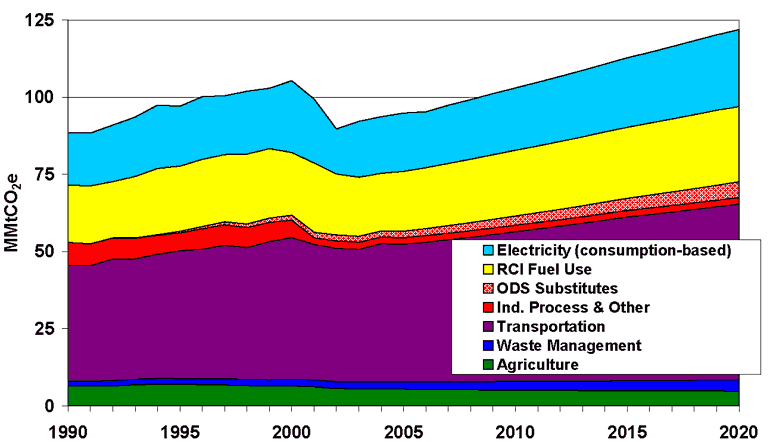
Source: Washington State Greenhouse Gas Inventory and Reference Case Projections, 1990-2020 [3]
Individually, industry, buildings, and electric power contribute much less than transportation, but when
combined, they currently produce 41 million metric tons of CO2 annually, nearly the same quantity of emissions
as the entire transportation sector (around 45 million metric tons).
Since 1972 the share of GHG emissions from electricity generation has steadily increased, as utilities
sought other (non-hydro) sources of energy to meet consumer demands. Today, hydro power produces about
66% of Washington’s electrical energy, but this percentage will probably decrease in the future. Hydroelectric
base load capacity will not likely grow, due to the prohibitive costs of building new plants. In fact, base load
capacity may well decrease due to climate change adaptation measures (providing water for irrigation and
fish) and reduced stream flows due to climate changes. The only way that we can achieve the kinds of goals
being discussed – e.g., 80% reduction in GHG by 2050 – is through changes in to our patterns of energy
production and use. The northwest will need major improvements in grids and heavy reliance on renewable
energy sources such as wind, solar, tides, biofuels, and geothermal. Efficiency, conservation, and distributed
generation must also grow. New ways of looking at how we power buildings – combined heat and power,
sending fuels (likely natural gas) to buildings that will generate their own electricity and using waste heat
from turbines to heat buildings. These changes must be combined with very large reductions in emissions
from the transportation sector. Changes of the required scale will require reductions in vehicle miles
traveled (VMT), higher efficiency vehicles, and lower carbon fuels – likely resulting in massive electrification
of vehicle fleets.
Figure 3: Washington State Electricity Fuel Mix
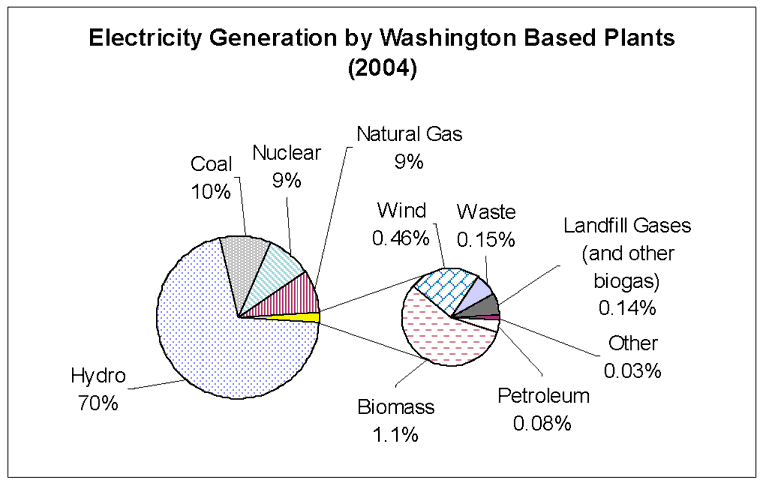
Source: Washington State Department of Commerce – Washington State Energy Indicators, 2005
Figure 4: Percent Total Statewide Energy Consumption, by Sector (2006)
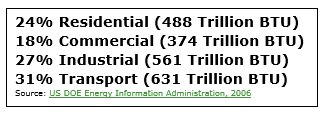
Energy Consumption
Of the four major energy sectors above, transportation consumes the most energy in Washington (Figure 3).
Even though transportation produces the largest share of greenhouse gas emissions, buildings from all
sectors dominate total energy consumption. This is due to the different power densities and GHG properties
of different fuels (natural gas, heating oil, gasoline, etc.). Combined with industrial production, buildings
represent 69% of state energy consumption.
How much energy we use and the GHG we produce has an impact on our quality of life now and into the
future. Saving energy requires both increased efficiency (like condensing furnaces, compact fluorescent
lamps (CFLs), light-emitting diodes (LEDs), etc., that provide the same amount of work or function output
but with less energy input) and conservation measures (like insulation and weatherization which reduce
the amount of energy needed).
The direct use of natural gas can be an important new conservation and pollution reduction tool[4]. Direct
use of natural gas for space and water heating, as well as cooking, produces about one-half the pollution
of using natural gas to first generate electricity in a central plant and then transmit it to commercial and
residential buildings.
In the near term, saving energy can mean saving money and enhancing our quality of life. In the long
term, reducing greenhouse gas emissions may help stave off the worst impacts of climate change. To
do both needs sound planning and effective actions.
Actions
Kent, Washington has instituted solar setback requirements in an attempt to preserve sunlight access
to parcels.
The following list of actions is separated into three categories: Getting Started, Making a Commitment,
and Expanding the Commitment. This categorical approach allows jurisdictions to implement measures
that are appropriate to their community’s current level of involvement in climate change and sustainability
issues and in consideration of locally adopted plans, codes, regulations, policies and goals.
Getting Started
3.3.1 Conduct a GHG inventory.
Software tools from ICLEI and other sources are now available to enable local jurisdictions to calculate
GHG emissions for both municipal operations and jurisdictions as a whole. Determining which elements
of your municipal operations and which sectors of your jurisdiction are the largest GHG emitters is an
essential first step for any energy use reduction plan. (Local Action) Even smaller towns, like Washougal
(population 13,880), have taken this step, see Project Example #1.
3.3.2 Create goals for reducing energy usage.
Once you have determined which sectors consume the most energy and produce the most GHG
emissions, you will be able to define specific goals for both municipal operations and the local jurisdiction
and determine what efficiency measures will most save energy, reduce GHG emissions, and protect or
improve the quality of life of your community. (Local Action)
3.3.3 Implement energy efficiency measures in municipal
buildings and operations.
Among a number of measures, some of the easiest (use of compact fluorescent light bulbs or new
electronic ballast fluorescent bulbs) can save substantial amounts of electricity. Likewise, starting
an energy management program and focusing on ways to improve the efficiency of heating and cooling
systems can result in substantial savings -e.g., automatic thermostats, individual room heating/cooling,
weatherization. (Local Action)
3.3.4 Incorporate energy policies into local Comprehensive Plans.
Integrate energy strategies into your Comprehensive Plan. Address energy efficiency, conservation,
and siting of new infrastructure. To reduce the energy use associated with transportation, encourage
the use of transit and non-motorized transportation as well as alternative, ultra-low emission fuels in fleet
vehicles. Consider ways to reduce energy use per traveler by supporting transit, encouraging neighborhood
commuter bicycle programs, and purchasing sustainable biodiesel for city fleets. (Local Action)
3.3.5 Work with your local utilities
Coordinate with your local and regional utilities regarding planning for new and upgraded energy infrastructure.
Be aware of energy efficiency programs and rebates offered by the utilities. Understand how and when the
utilities need to be involved in the development of energy efficiency programs. (Local Action)
3.3.6 Create a Resource Conservation Management Program.
A local Resource Conservation Manager (RCM) would be responsible for identifying and implementing specific
municipal and community-wide energy programs. (As part of their Comprehensive Plan update, the City of
Langley on Whidbey Island created, a Community Resource Conservation Manager (CRCM) position based on
Puget Sound Energy’s own Resource Conservation Manager program.[5] This position can cover small-scale
energy generation (such as renewables) as well as energy efficiency, and can significantly impact both demand
and supply of sustainable energy in your community. Washington State University’s Energy Program has an
active Resource Conservation Management Program and will be funding training for several local shared
Resource Conservation Managers CMs with ARRA funding. (Local Action)
Making a Commitment
3.3.7 Apply for State and Federal Energy Efficiency Grants.
The renewed interest in energy conservation and greenhouse gas reduction by the federal government has
led to new grant opportunities. The American Recovery and Reinvestment Act of 2009 appropriated $3.2 billion
for the Energy Efficiency and Conservation Block Grant (EECBG) Program. This program awards grants to local
governments and tribes to develop and implement a wide range of clean energy programs, including energy
conservation strategies, energy audits and retrofits, energy conservation in transportation, energy distribution
technologies, recycling programs that increase energy efficiency, and renewable energy technologies. At
publication time (September 2009) the deadline for applications from larger jurisdictions has passed. However,
if your city has less than 35,000 in population, you may still be eligible for competitive grants through the
Washington State Department of Commerce. Planners should also watch the U.S. Department of Energy
website for other grant opportunities under the Energy Efficiency and Renewable Energy (EERE) program.
(Local Action)
3.3.8 Use Block Grants to motivate private financing for ongoing energy
conservation retrofits.
In Bellingham, Washington, Sustainable Connections – a non-profit business group – partnered with the
Energy Efficiency Finance Corporation of Olympia to create a $500,000 loan loss reserve fund from Block
Grant stimulus dollars to leverage local private banks to create energy efficiency retrofit loans. Other local
governments are using state funding to create interest rate buy-down programs that reduce the interest rate
on energy conservation loans. (Local Action)
3.3.9 Utilize energy audit and efficiency programs offered by utilities.
A number of efficiency incentive programs are offered; for example, Puget Sound Energy offers incentives for
new construction and energy retrofits, and Chelan County Public Utility District (PUD) offers a rebate program
for commercial and industrial users. Many PUDs and utilities across the state offer loan and rebate programs
for energy efficiency measures, including money for solar heating, weatherization, LEED certification, and public
infrastructure upgrades. (Local Action)
3.3.10 For cities with ports or large industrial and shipping facilities, work to
install electrical hookups to reduce diesel idling.
Public works departments, port authorities and private companies may be interested in helping provide power to
freighters and semi trucks for powering refrigeration units and other systems while being loaded, to reduce
vehicle idling times. (Local Action)
3.3.11 Accommodate hybrid vehicles, plug-in electric vehicles, and alternative
fuel vehicles.
Meeting greenhouse gas reduction goals will require more efficient vehicles using lower carbon fuels. In addition
to more efficient conventional vehicles, advanced technology vehicles and alternate fuel vehicles will play a vital
role. While these vehicles are not yet common, it is important to identify and plan for infrastructure needs now.
Mixtures of biodiesel and diesel can fuel buses and garbage vehicles.
Through the Emergency Economic Stabilization Act of 2008, the U.S. congress has passed into law a
federal-level Investment Tax Credit for 30% of the installed cost of small wind turbines for home, farm, or
business use.
(Use a biodiesel based on waste grease or algae biofuels rather than palm or soy-based biodiesel to avoid
impacts on food supplies and prices.) are very new, but consider Electric vehicles (EV) and plug-in hybrids
(PHEV)) when purchasing municipal vehicles. Include infrastructure for these vehicles in new project plans.
State and federal funds can support electric vehicle plug-in stations that will encourage the public use of
these vehicles. (Local Action)
3.3.12 Create local government demonstration projects for green energy.
Various non-profits such as the Washington Solar Energy Association, Northwest Energy Coalition and
Northwest SEED work on policies and projects to advance energy efficiency and support community
renewable energy projects. Find out what local, citizen-based non-profits are advocating for sustainability
and renewable energy and partner with them to create a community-based renewable energy project.
(Local Action)
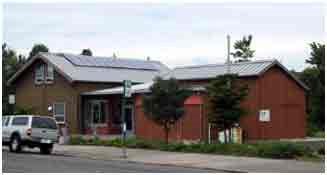
Bellingham’s Environmental Learning Center
3.3.13 Purchase green power.
Most investor-owned and public utilities provide an option to customers to purchase power from renewable
sources or to direct that a portion of their utility payments be directed toward investments in renewable
energy. Communities can demonstrate leadership by making the green power pledge – in 2006, Bellingham
approved the purchase of 100% of the city’s electricity from renewable resources. (Local Action) In 2007,
Bellingham’s Green Power program was named EPA’s Green Power Partner of the Year, see
Project Example #2.
Expanding the Commitment
3.3.14 Balance issues of protecting and enhancing tree canopy with
solar access for energy use.
Draft a local renewable or solar access ordinance with potential conflicts in mind. Various agencies, including
the City of Seattle, are engaged in developing and implementing a model statute and ordinance. [6]
(Local Action)
Community Energy Solutions
Community Energy Solutions, a non-profit on Bainbridge Island recently installed a 5.1 kilowatt solar array on
the Bainbridge Sakai School. The project benefitted from a $25,000 grant from PSE’s Solar Schools program
that provided the starter solar system of 1.1 kilowatts and included student curriculum and a public kiosk.
Community Energy Solutions raised an additional $30,000 for the additional 4 kilowatts of panels in less than
3 months through community outreach.
Another community project is the community solar project in Ellensburg, Washington – a partnership with the
City of Ellensburg and the Bonneville Environmental Foundation.
3.3.15 Create siting standards and ordinances for renewable energy facilities.
Determine conditions to allow development of individual and commercial wind, solar, or other renewable energy
in appropriate areas. For example, commercial wind farms should be sited to capture predictable, abundant
wind energy. Small wind power generally is most effective on individual lots large enough to accommodate a
typical setback of 1.1 times the tower height. You can support evolving technologies such as devices to capture
wind on rooftops for wind generation in urban areas, where appropriate. Excellent articles by premier small and
community wind power experts Paul Gipe and Mick Sagrillo can be found at Wind-Works. The American Wind
Energy Association provides a number of valuable resources including “In the Public Interest, How and Why to
Permit for Small Wind Systems, a Guide for Local and State Governments”. Transmission of power from the
generation site to a load center is also required. This may require siting standards and environmental trade-offs,
even if new and/or upgraded transmission facilities are located in existing transmission corridors. (Local Action)
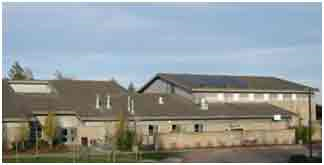
Solar panels on Sakai Intermediate School in Bainbridge Island, WA
3.3.16 Partner to build a community energy project.
Partner with community groups or schools to build alternative energy projects that support the local community
and that demonstrate solutions for local businesses and residents. (Local Action) A local non-profit group has
partnered with the Bainbridge Island school district to add solar panels to the local intermediate school, see
Project Example #3.
3.3.17 Remove regulatory barriers to on-site “distributed energy” projects.
Distributed energy provides an exciting array of possibilities for on-site energy generation and efficiency
strategies. The California Energy Commission defines distributed energy resources as “small-scale power
generation technologies, typically in the range of 3 to 10,000 kW, located close to where electricity is used
(e.g., a home or business) to provide an alternative to or an enhancement of the traditional electric power
system.”
Washington already has two programs in place to support small renewable energy projects. First, net
metering allows customers to use the energy they generate to “spin the meter backwards” to receive
credit for excess energy produced. Additionally, the state has a production incentive payment which pays
the customer for energy produced even if it is used by the customer. Several households are already
producing more electricity than they use on an annual basis.
Some utilities in Washington already offer incentives for distributed energy, and non-profit funding
sources, such as the Bonneville Environmental Foundation, accept proposals for funding renewable
energy projects in the Northwest. (Local and Regional Action)
3.3.18 Support your municipal or private utility in preparing for the smart
grid and increased electrification.
One funding opportunity is the Smart Grid Demonstration program, offered through the Bonneville Power
Administration and funded by the U.S. D.O.E. as part of the American Recovery and Reinvestment Act of 2009.
The project is meant to “support regionally unique demonstration projects to quantify smart grid costs, benefits
and cost-effectiveness, verify smart grid technology viability, and validate new smart grid business models, at
a scale that can be readily adapted and replicated around the country.
“Smart Grid” is a common reference to a set of emerging technologies for applying digital technologies
to managing the electric distribution system[7] Smart grid technology is in its infancy as an emerging
technology. Yet, with its advantages for consumer real-time energy use cost data, more efficient homeowner
system use, and more efficient operations for the utility, it is likely to become the new standard. Work with
local electric utility representatives to see if they are working on a smart grid pilot, and identify ways your
municipal government can help with a pilot project proposal.
Increased electrification to reduce GHG emissions can require upgrading or new construction of transmission
and distribution systems in areas where the existing systems do not have the capacity needed to accommodate
this increased use. This is especially true where new transmission corridors are required to move power from
new generation sites to distribution utilities. Work with local utilities to accommodate required facilities.
(Local Action)
Additional Resources
A number of excellent resources relating to energy conservation, renewable energy and energy planning,
as well as sources of funding, are available on the web.
Municipal Research and Services Center of Washington (MSRC) – A non-profit web-based information
resource for local governments.
Footnotes
1 The Fifth Northwest Electric Power and Conservation Plan, Northwest Power and Conservation Council,
Section 2, pg 6.
2 http://www.commerce.wa.gov/DesktopModules/CTEDPublications/CTEDPublicationsView.aspx?tabID=0&ItemID=4084&MId=863&wversion=Staging
3 Washington State Department of Commerce, About Growth, Spring 2008. http://www.commerce.wa.gov/DesktopModules/CTEDPublications/CTEDPublicationsView.aspx?tabID=0&ItemID=6155&MId=944&wversion=Staging
4 Validation of Direct Natural Gas Use to Reduce CO2 Emissions, Gas Technology Institute,, 2009. http://www.ingaa.org/cms/28/8776.aspx
5 Washington State Greenhouse Gas Inventory and Reference Case Projections, 1990-2020 http://www.ecy.wa.gov/climatechange/docs/WA_GHGInventoryReferenceCaseProjections_1990-2020.pdf
6 Kettles, Colleen McCann, A Comprehensive Review of Solar Access Law in the United States: Suggested
Standards for a Model Statute and Ordinance, Florida Solar Energy Research and Education, Solar America
Board for Codes and Standards, 2008 http://www.solarabcs.org/solaraccess/Solaraccess-full.pdf see also http://www.solaramericacities.energy.gov/PDFs/2009_Annual_Meeting/Understanding_Codes_Standards/Solar_Access_Law.pdf
for reference to Seattle program.
7 For a layman’s introduction to Smart Grid technologies, see http://www.oe.energy.gov/DocumentsandMedia/DOE_SG_Book_Single_Pages(1).pdf. Locally, Climate Solutions
has also published an excellent overview of how Smart Grid technology can revolutionize power generation and
distribution in the Northwest. http://www.climatesolutions.org/solutions/reports/powering-up-the-smart-grid-a-northwest-initiative-for-job-creation-energy-security-and-clean-affordable-electricity/PoweringUpTheSmartGrid.pdf
Prev | Table of Contents | Next
|







